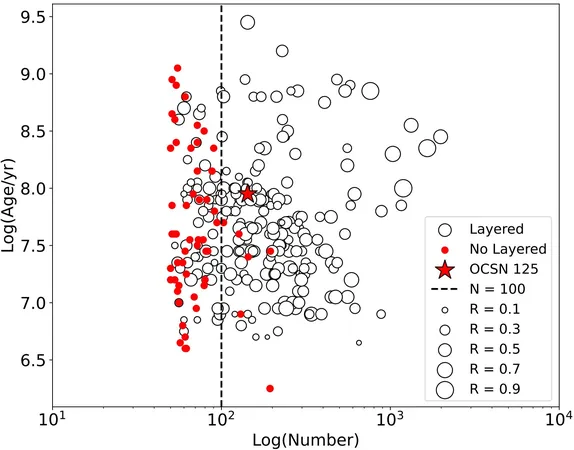
Unlocking the Secrets of Stellar Formation: How 3D Structures Shape Open Star Clusters
2025-07-07
Author: Charlotte
A Groundbreaking Study on Open Star Clusters
Scientists at the Xinjiang Astronomical Observatory have uncovered pivotal insights into the 3D layered structures of open star clusters, shedding light on the very fabric of our universe. By diving deep into N-body simulations and examining 279 nearby open clusters, they discovered a striking link between the number of stars in a cluster and the formation of these intriguing spatial structures.
More Stars, More Structure!
Their research, recently published in Astronomy & Astrophysics, reveals that clusters with fewer stars often lack the complex layering seen in larger groups. Clusters boasting over 100 member stars are significantly more likely to exhibit these fascinating 3D formations.
The Role of Massive Stars and Binaries
But what drives this phenomenon? Follow-up simulations suggest that two main factors are crucial: the initial fraction of binary stars and the mass of the heaviest star in the cluster. Massive stars, those exceeding eight times the mass of our sun, push the boundaries of stellar dynamics through their powerful supernovae and stellar winds, leading to a potential weakening of the core's layered structure.
Dynamics in Action: How Structures Evolve
Binary systems, on the other hand, play a dual role by slowing down core collapse and stabilizing the intricate layers through energy sharing, gravitational disturbances, and dynamic interactions. When the binary fraction is high, the cluster can become isotropic, causing the once-prominent layering to almost vanish.
A New Perspective on Stellar Evolution
This enlightening study not only emphasizes the essential impact of massive stars and binary configurations on the evolution of open clusters, but it also provides a fresh dynamical framework to understand how these cosmic structures form and evolve over time. As we continue to explore the cosmos, these newfound insights could redefine our understanding of star formation and the complex dance of celestial bodies.









 Brasil (PT)
Brasil (PT)
 Canada (EN)
Canada (EN)
 Chile (ES)
Chile (ES)
 Česko (CS)
Česko (CS)
 대한민국 (KO)
대한민국 (KO)
 España (ES)
España (ES)
 France (FR)
France (FR)
 Hong Kong (EN)
Hong Kong (EN)
 Italia (IT)
Italia (IT)
 日本 (JA)
日本 (JA)
 Magyarország (HU)
Magyarország (HU)
 Norge (NO)
Norge (NO)
 Polska (PL)
Polska (PL)
 Schweiz (DE)
Schweiz (DE)
 Singapore (EN)
Singapore (EN)
 Sverige (SV)
Sverige (SV)
 Suomi (FI)
Suomi (FI)
 Türkiye (TR)
Türkiye (TR)
 الإمارات العربية المتحدة (AR)
الإمارات العربية المتحدة (AR)